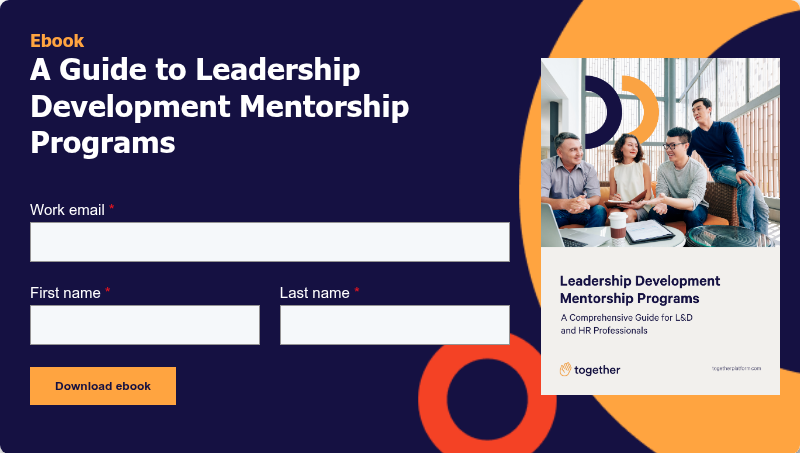Picture this scenario: Six months ago, your organization launched a leadership mentorship program with great fanfare. Executive leaders championed it, high-potential employees eagerly applied, and experienced managers stepped up as mentors. Fast forward to today, and you're facing some uncomfortable realities.
Some mentoring relationships never gained traction. Others started strong but fizzled out after a few months. A few mentees are complaining about mismatched expectations, while several mentors feel unprepared for their role. Despite your best intentions and careful planning, your program is delivering mixed results at best.
Sound familiar? You're not alone. After analyzing hundreds of mentorship programs across various organizations, certain failure patterns emerge repeatedly. The good news is that these pitfalls are both predictable and preventable.
This guide examines the most common mentorship program killers and provides practical strategies for avoiding them. By learning from others' mistakes, you can design and implement a program that delivers transformational results rather than disappointing outcomes.
Pitfall #1: The "Set It and Forget It" Mentality
The Problem
Many organizations launch mentorship programs with enthusiasm but then assume relationships will manage themselves. They provide initial training, make introductions, and then step back, expecting mentors and mentees to figure everything out independently.
This approach leads to several predictable problems:
- Relationships lose momentum without ongoing support
- Participants encounter challenges they don't know how to address
- Quality varies dramatically across different mentor-mentee pairs
- Program administrators lose visibility into relationship health and outcomes
The Warning Signs
Declining engagement metrics:
- Meeting frequency dropping below program guidelines
- Decreased participation in optional program events
- Increased requests for mentor-mentee re-matching
Participant feedback indicating lack of support:
- Comments about feeling "left on their own"
- Requests for more guidance and structure
- Complaints about unclear expectations or goals
- Reports of relationship conflicts with no resolution path
The Solution
Build ongoing support into your program design from the very beginning:
Regular check-ins and pulse surveys:
- Monthly brief surveys to identify issues early
- Quarterly more comprehensive relationship health assessments
- Rapid response protocols for addressing problems
- Trend analysis to identify systematic issues
Ongoing learning and development opportunities:
- Monthly group sessions for peer learning and troubleshooting
- Advanced training modules for experienced participants
- Guest speakers and expert panels on leadership topics
- Best practice sharing sessions across mentor-mentee pairs
Clear escalation and support paths:
- Designated program coordinators for participant support
- Defined processes for addressing relationship challenges
- Expert consultation available for complex situations
- Re-matching protocols when relationships aren't working
Continuous resource development:
- Regular updates to conversation guides and development tools
- New content based on participant feedback and needs
- Integration of latest research and best practices
- Customized resources for specific development challenges
Pitfall #2: Poor Matching Equals Program Failure
The Problem
Random or superficial matching destroys participant enthusiasm and program credibility faster than almost any other factor. When mentors and mentees are poorly matched, relationships never develop authentic connection, learning opportunities are limited, and both parties become frustrated with the program.
Common matching mistakes include:
- Pairing based solely on availability or convenience
- Matching by demographic characteristics without considering compatibility
- Ignoring personality differences and communication style preferences
- Failing to align mentor expertise with mentee development needs
The Warning Signs
High re-matching requests:
- Multiple participants asking to change mentors or mentees
- Relationships ending prematurely without clear cause
- Feedback indicating "we just don't click"
- Low meeting frequency despite program requirements
Misaligned expectations and goals:
- Mentors and mentees working toward different objectives
- Conversations lacking focus or direction
- Frustration about irrelevant advice or guidance
- Participants questioning program value
The Solution
Invest in thoughtful, data-driven matching processes:
Comprehensive intake and assessment:
- Detailed surveys capturing goals, preferences, and communication styles
- Assessment of leadership competencies and development areas
- Career aspiration and progression timeline alignment
- Learning style and personality compatibility evaluation
Multiple matching criteria weighted by importance:
- Functional expertise and industry knowledge alignment
- Leadership development needs and mentor strengths matching
- Communication style and personality compatibility
- Geographic location and schedule availability
- Career stage and experience level appropriateness
Trial periods and adjustment opportunities:
- 60-90 day trial periods for all new relationships
- Structured check-ins during trial periods
- No-penalty re-matching if compatibility issues arise
- Feedback collection to improve future matching decisions
Technology-enabled matching optimization:
- Algorithms that analyze multiple data points simultaneously
- Matching quality scoring and optimization
- Historical data analysis to improve matching accuracy
- Participant feedback integration to refine matching criteria
Pitfall #3: Unclear Expectations and Goals
The Problem
Vague objectives lead to vague outcomes. When mentors and mentees don't have clear, specific goals for their relationship, conversations lack focus, progress is impossible to measure, and both parties become frustrated with the lack of direction.
This pitfall manifests in several ways:
- General goals like "become a better leader" without specific competencies
- Misaligned expectations between mentors and mentees
- Confusion about meeting frequency, duration, and format
- Lack of progress tracking and milestone recognition
The Warning Signs
Unfocused conversations and activities:
- Participants reporting that meetings "lack purpose"
- Conversations that jump between topics without depth
- No clear agenda or preparation for mentoring sessions
- Feedback indicating relationships feel "social" rather than developmental
Lack of progress measurement:
- No documented goals or development objectives
- Inability to articulate learning or growth achieved
- No tracking of skill development or behavior change
- Participants unsure whether they're "succeeding" in the program
The Solution
Provide clear structure while maintaining relationship flexibility:
SMART goal-setting workshops and templates:
- Training on creating Specific, Measurable, Achievable, Relevant, Time-bound goals
- Templates for documenting development objectives and success criteria
- Regular goal review and adjustment processes
- Connection between mentorship goals and broader career aspirations
Comprehensive onboarding and expectation setting:
- Clear communication about program structure and requirements
- Role definitions for both mentors and mentees
- Meeting frequency, duration, and format guidelines
- Confidentiality and professional boundary expectations
Structured conversation guides and development tools:
- Monthly conversation topic suggestions and question frameworks
- Development exercises and assessment tools
- Progress tracking templates and milestone checklists
- Resource libraries aligned with common development goals
Regular progress review and goal adjustment:
- Quarterly goal review sessions for all mentor-mentee pairs
- Mid-program comprehensive development assessment
- Goal adjustment processes based on progress and changing needs
- Celebration and recognition of achievement milestones
Pitfall #4: Inadequate Mentor Training
The Problem
Being a successful leader doesn't automatically make someone an effective mentor. Many organizations recruit their best performers as mentors but provide minimal training on mentoring skills, coaching techniques, or adult development principles.
This leads to several predictable problems:
- Mentors who try to solve problems rather than develop problem-solving skills
- Advice-giving that doesn't fit the mentee's situation or learning style
- Inability to provide constructive feedback effectively
- Frustration when mentees don't implement suggestions or make expected progress
The Warning Signs
Mentor feedback indicating uncertainty or frustration:
- Requests for more guidance on "how to mentor"
- Reports of difficult conversations or relationship challenges
- Uncertainty about their role and responsibilities
- Frustration when mentees don't follow their advice
Mentee feedback suggesting inadequate mentoring:
- Comments about receiving too much advice rather than development
- Feeling that mentors don't understand their specific challenges
- Lack of skill development or behavior change
- Requests for mentor changes due to "style" differences
The Solution
Provide comprehensive mentor development that goes beyond basic orientation:
Core mentoring skills training:
- Coaching and facilitation techniques rather than advice-giving
- Active listening and powerful questioning skills
- Feedback delivery and difficult conversation management
- Understanding of adult learning principles and development psychology
Program-specific preparation:
- Understanding of organizational leadership competency models
- Knowledge of available development resources and tools
- Familiarity with program structure, expectations, and support systems
- Training on specific development challenges common in your organization
Ongoing mentor development opportunities:
- Monthly mentor circles for peer learning and consultation
- Advanced training modules on specialized mentoring topics
- Access to external mentoring resources and expert consultation
- Recognition and professional development opportunities for effective mentors
Support systems and quality assurance:
- Regular coaching and feedback for mentors from program staff
- Peer mentoring relationships among mentors themselves
- Clear escalation paths when mentors encounter challenges
- Quality metrics and improvement feedback for mentor effectiveness
Pitfall #5: Diversity and Inclusion Oversights
The Problem
Mentorship programs can inadvertently perpetuate existing organizational inequalities if they're not designed with intentional diversity and inclusion considerations. This happens when programs:
- Recruit mentors primarily from existing senior leadership (often homogeneous)
- Fail to address cultural differences in mentoring expectations and communication styles
- Don't provide cultural competence training for cross-cultural mentoring relationships
- Overlook microaggressions and bias that can undermine mentoring effectiveness
The Warning Signs
Demographic patterns in participation and outcomes:
- Mentor pool lacks diversity across key demographic dimensions
- Participation rates vary significantly across different employee groups
- Outcome differences between different demographic groups
- Feedback indicating cultural misunderstandings or discomfort
Program design that doesn't account for diverse experiences:
- One-size-fits-all approach that doesn't accommodate different communication styles
- Lack of cultural competence training for participants
- No specific support for cross-cultural mentoring relationships
- Absence of diverse perspectives in program design and leadership
The Solution
Design inclusion intentionally into every aspect of your program:
Diverse mentor recruitment and development:
- Active recruitment of mentors from diverse backgrounds and career paths
- External mentor partnerships to supplement internal diversity
- Specific outreach to underrepresented groups for mentor participation
- Recognition that effective mentors come from various organizational levels
Cultural competence and bias training:
- Training for all participants on cultural differences in communication and leadership styles
- Bias awareness and interruption skill development
- Specific preparation for cross-cultural mentoring relationships
- Resources for navigating cultural differences constructively
Inclusive program design and support:
- Multiple mentoring formats to accommodate different preferences and needs
- Flexible meeting structures that work for diverse schedules and commitments
- Targeted support for participants from underrepresented groups
- Regular analysis of program outcomes by demographic groups
Continuous improvement and accountability:
- Regular assessment of program inclusivity and effectiveness across different groups
- Feedback collection specifically focused on inclusion and belonging
- Program adjustments based on differential outcomes or experiences
- Leadership accountability for creating inclusive mentoring experiences
Pitfall #6: Executive Support That's Only Surface-Deep
The Problem
Many programs suffer from executive support that looks good on paper but lacks substance in practice. Leaders endorse programs publicly, approve budgets, and may even volunteer as mentors, but they don't provide the real resources, time allocation, and organizational integration necessary for success.
This superficial support undermines programs in several ways:
- Participants don't take the program seriously if leaders don't demonstrate genuine commitment
- Competing priorities consistently trump mentoring activities
- Resources are allocated inadequately or inconsistently
- Program goals aren't integrated with broader talent management and succession planning
The Warning Signs
Resource constraints and competing priorities:
- Consistent budget cuts or resource reallocation away from mentoring
- Participants struggling to find time for mentoring activities
- Limited administrative support for program management
- Lack of integration with performance management and development planning
Mixed messages about program importance:
- Leadership actions that contradict stated program support
- Mentoring activities consistently deprioritized for "urgent" business needs
- No consequences for managers who don't support employee participation
- Program updates absent from leadership meetings and communications
The Solution
Secure genuine leadership commitment that goes beyond endorsement:
Executive participation and modeling:
- Leadership sharing their own mentoring experiences and development stories
- Visible executive engagement in program events and celebrations
- Integration of mentoring into executive performance expectations
Resource allocation and organizational integration:
- Adequate budget allocation for technology, training, and administration
- Protected time for mentoring activities in workload planning
- Integration with performance management and succession planning processes
- Clear expectations for manager support of employee participation
Communication and accountability:
- Regular leadership communication about program importance and value
- Integration of program updates into executive meetings and communications
- Accountability metrics for leadership support of development activities
- Recognition and consequences based on leadership support of mentoring
Strategic alignment and measurement:
- Clear connection between mentoring outcomes and business objectives
- Regular reporting on program impact and ROI to executive leadership
- Integration with strategic talent management and organizational development
- Long-term commitment to program sustainability and evolution
Learning from Failure: Building Resilient Programs
The most successful mentorship programs are those that anticipate potential pitfalls and build resilience into their design. Rather than reacting to problems after they occur, proactive programs create systems and processes that prevent common failures and enable rapid recovery when challenges arise.
Building Early Warning Systems
Predictive analytics and trend monitoring:
- Data collection systems that identify problems before they become serious
- Regular analysis of engagement patterns and relationship health indicators
- Participant feedback systems that surface issues quickly
- Benchmarking against best practices and external programs
Rapid response capabilities:
- Clear protocols for addressing different types of challenges
- Trained staff available for participant consultation and support
- Flexible program design that can adapt to changing needs
- Learning systems that capture and apply lessons from challenges
Creating Learning Organizations
Continuous improvement culture:
- Regular program review and update cycles based on participant feedback and outcome data
- Experimentation and pilot testing of new approaches and features
- External learning through conferences, research, and peer organization collaboration
- Innovation reward systems that encourage creative problem-solving
Knowledge management and sharing:
- Documentation of lessons learned and best practices
- Systems for sharing insights across different mentor-mentee pairs and cohorts
- Integration of external research and best practices into program design
- Alumni networks that continue learning and improvement beyond formal program participation
Your Pitfall Prevention Strategy
Avoiding common mentorship pitfalls requires proactive design, continuous attention, and willingness to learn from both your own experiences and others' mistakes. Use this guide as a diagnostic tool to assess your current or planned program against these common failure patterns.
Remember that program excellence is not about perfection—it's about building systems that anticipate challenges, respond quickly to problems, and continuously improve based on learning and feedback. The best programs are those that evolve and adapt while maintaining focus on their core mission of developing leadership capability.
For a complete program design toolkit that includes pitfall prevention checklists, diagnostic tools, and improvement frameworks, download our comprehensive resource: "Leadership Development Mentorship Programs: A Comprehensive Guide for L&D and HR Professionals."
This guide provides everything you need to build mentorship programs that avoid common pitfalls while delivering transformational development experiences and measurable business impact.
Download the Leadership Development Mentorship Programs Ebook →



.svg)







.svg)

